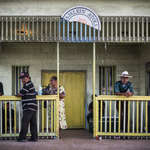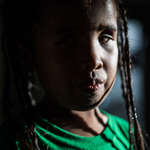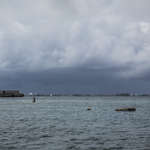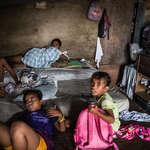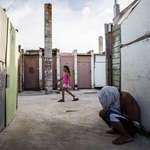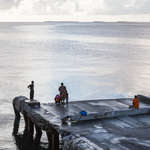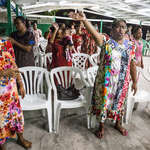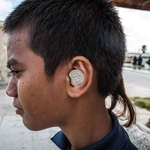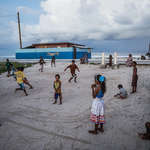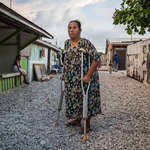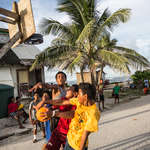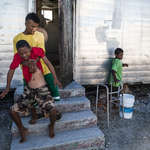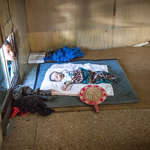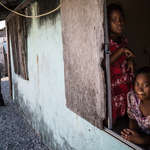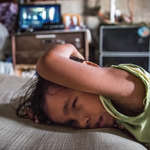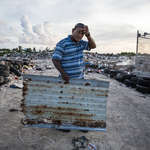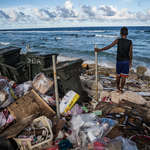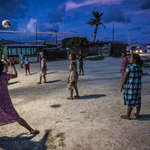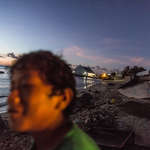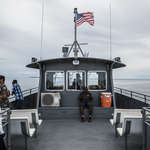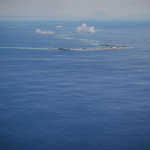
-
The tiny island of Ebeye in Kwajalein Atoll, Marshall Islands, has a total area of 0.36 square kilometres and is home to over 13,000 people, most of whom were moved there from nearby islands because of a US Army missile range-testing program that was launched in the late 1940s. Overcrowding, poverty, outbreaks of infectious diseases and a high level of unemployment has led some to refer to Ebeye as the ‘ghetto of the Pacific’. Until the 1940s, the island’s population was negligible. During the Second World War, Japan occupied the Marshall Islands and moved some 1,000 settlers there and when the US captured the islands in 1944, a new naval base and the movement of people from other parts of the Atoll rapidly augmented Ebeye’s population.
In preparation for ‘Operation Crossroads’, an extensive missile testing programme that would eventually comprise 67 blasts, the US military decided to move all non-US personnel from around the Kwajalein Atoll onto Ebeye, which lies around five kilometres north of Kwajalein Island, the largest in the Atoll. On 1 March 1954, under the code name of ‘Castle Bravo’, the US military detonated a dry fuel hydrogen bomb on Bikini Atoll, in the north of the island chain, which was to be the most powerful nuclear device every debated by the United States.
-
Though the Bikini Islanders had been persuaded to relocate to a neighbouring island in 1946, where they had suffered shortages and malnutrition, members of other nearby communities on Rongelap island were not evacuated until 3 days after the blast, causing many to suffer the effects of radiation sickness and birth defects.
Keen to return to their ancestral lands, Bikini islanders were tentatively allowed to come back to their homes three years after ‘Castle Bravo’ but had to be moved again after many developed leukaemia and thyroid tumours.
Over the coming decades, some islanders continued to return and try to reestablish their old communities but periodic tests of the soil, water and plant life on Bikini islands consistently suggested that the place had been so polluted by the nuclear fallout of ‘Castle Bravo’ and other tests that it was unsafe to live on the Atoll any longer. Many Bikini Islanders ended up on Ebeye, now the most densely populated of the Marshall islands, with the help of Greenpeace which in 1985 organised a mass evacuation from areas affected by fallout.

-
As the US nuclear testing programme developed and grew in the 1950s, most of the people living around the Kwajalein Atoll where various US military installations that assist the nuclear test sites are based were relocated from their homes and into a planned settlement on Ebeye. After they were joined by the ‘nuclear migrants’ from Bikini and other northern atolls, the poorly constructed settlements on Ebeye became increasingly crowded, leading to a polio outbreak in 1963, a measles outbreak in 1978 and regular occurrences of cholera, tuberculosis and other diseases up to the present day.The most overcrowded settlement of Northern Camp is a large shanty town without water supply or sewage system. Since much of the population is dependent on the service industry at US installations, unemployment is a major problem.
-
According to health workers at Ebeye’s hospital, ongoing missile testing around Kwajalein Atoll continues to impact on the health of local people. ‘When the Americans test their missiles and then the rain comes, the entire population of Ebeye gets sick. We have diarrhoea, flu and conjunctivitis. Such symptoms continue for 10 to 15 days and then everyone gets better until the next tests’ he says. And while US personnel enjoy excellent health care in places like Kwajalein Hospital, the majority of Ebeye residents who need emergency care are often referred to hospitals in Majuro, the administrative capital of the Marshall Islands, or to Manila or Hawaii since they do not have clearance to enter military installations.
Children playing the 'Cemetery' game on one of the Ebeye's sandy beaches. The overpopulated island is informally known as the 'slum of the Pacific'. It people suffer numerous diseases and the mortality rate is one of the highest in the Republic of the Marshall Islands.
Ebeye Island, an area of only 0.36 square kilometres, has a population of more than 13 thousand people, many of whom were relocated from other atolls as a result of nuclear testing that the American military began to conduct post WWII. Ebeye subsequently became overpopulated and is informally known as the 'slum of the Pacific'.
Members of the Mormon Church baptise 16 year old Linty Lang in the waters of the Pacific Ocean. Ebeye became a magnet for missionaries from many religious groups and churches for whom Ebeye is a convenient place to set up base and is itself populated by more than 13 thousand poor and socially deprived ideal potential recruits.
A group of men gather in a shelter to socialise. About 90 percent of the island's residents are unemployed. Hiding from the equatorial heat in their houses during the day, in the evening they go out to enjoy the evening freshness and get the latest news.
North Camp, one of the most populated areas on Ebeye, which is informally known as the 'Pacific ghetto'. A 2011 government report stated that 9,614 people lived per square mile on Ebeye.
Children play among the detritus of a rubbish dump. Children and many unemployed adults often go to the dump in search of any discarded items that they can use. Previously the land was used as a softball field, but lately the local authorities decided to move it to one of the neighbouring islands immediately to the north of Ebeye that are connected with the island by causeway.
Residents of Ebeye in front one of the government buildings.
George Junior (24) a health worker at the Ebeye public hospital with his wife Angela (23) and children Angeline (2) and Brangie (2 months) in their house. George says that every time the U.S. military test their ballistic missiles and the rains fall, all the population of Ebeye gets sick with diarrhoea, conjunctivitis and flu.
Cathy, 9, was born blind and her legs paralysed. Her parents blame the the American nuclear program for the disability of their daughter. After several operations at a hospital in Hawaii, paid for by the Government of the Marshall Islands, she is now able to walk.
A man with his children riding a tricycle near an abandoned house on the shore of Ebeye island. Due to the erosion of the coastline, several houses have been destroyed.
Mido, 78, spent most of her life on Ebeye. Now she lives in an abandoned house with her daughter and grandchildren. As immigrants, the do not own land on the island and therfore are not allowed to build.
The view from Ebeye to the US military base on Kwajalein Island. There is a huge discrepancy between the standards of living on the two islands. Most of the residence of Kwajalein are American military.
Elita Lugky, 35, sits beside her paralysed daughter Printess, 7, in their house in the North Camp slum. Printess was born prematurely and became paralysed after she contracted polio. Her mother blames American nuclear testing for her polio and all the misfortunes that her family suffered. In 1954, following the Castle Bravo hydrogen bomb test, Elita's parents were evacuated, along with the entire population, from Rongelap Atoll to Ebeye. Many of the Rongelap Atoll inhabitants developed leukaemia and tumours of the thyroid gland after being exposed radioactive fallout from the test. They were allowed back to the atoll three years later but after years of illness enviromental group Greenpeace moved them to Mejato and Ebeye islands.
People outside their houses as dusk falls.
Children lying on matresses placed on the floor of a room in an overcrowded house. Often several families live in one home.
A resident of Ebeye sitting next to the toilets, each of which is locked and belongs to a separate family from the North Camp. Most of the houses in the slum have no water supply and sewage system.
Ebeye residents look toward the Kwajalein Atoll's outer islands, that for many were once home. 11 of the 97 islands of the atoll were rented to the US military for use in the missile defence program and are closed to the public. Residents of several other islands of the so-called Mid-Corridor group can get to their home island only during three six-week periods each year, at a time when there are no missile tests conducted.
Oved, 62, sitting on a grave in one of many Ebeye cemeteries. Because of extreme overcrowding all local cemeteries are full and now serve as a place of games for children and drinking alcohol for adults. Deceased people are usually buried on outer islands as there is no room left in the islands cemeteries.
Relatives of a deceased person sit around the coffin on a boat that will take them to one of the outer islands of the atoll where the funeral will occur. Because of overcrowding of Ebeye, all island's cemeteries are full.
A night prayer at a local church.
Jason, 11, on a street of Ebeye with a coin in his ear.
A man pushes his wheelchair-bound disabled relative along a street. Ebeye, one of the most densely populated islands in the world and is home to a large number of variously disabled people. Aside from the nearby nuclear testing sites, overcrowding, poor sanitation, and the failure of the US administration to immunise the population of Ebeye has meant that its residents has suffered a high degree of diseases such as tuberculosis, polio, hepatitis, influenza, measles, cholera etc.
Patients in the waiting room of the renovated Leiroj Kitlang Memorial Health Centre.
Children playing on the streets of Ebeye. More than half of the island's inhabitants are children under 18 years of age. According to UNICEF, the increasing urbanisation of many Pacific islands prevents children from poor families from acessing health care and education. Ebeye has more than a thousand children that do not attend school due to overcrowding and lack of teachers.
Erina Paul, 55, near her house. Erina's family was relocated from Rongelap Atoll after Americans tested the 'Castle Bravo' nuclear device on nearby Bikini Atoll. In 1963 Erina became paralysed after catching polio after an epidemic hit the island; the incidence of affection reached 91.3 per 1000 and caused eleven deaths and 212 recorded cases of full or partial paralysis. Professional observers blamed the outbreak of polio in part on the American administration's failure to immunise the population of Ebeye against the disease despite the existence of an approved, available, and cost-efficient vaccine.
Hiroshi, 13, plays along with his friends on the rusty remains of machines abandoned on the coast of the island.
Teenagers trying to 'catch a wave', 'surfing' with any available floating materials.
Youths playing basketball, one of the most popular sports among young people on the island. Several dozen makeshift basketball courts have been constructed on the island.
People in one of the many island's billiard bars.
A man carries a plastic vessel of drinking water. Many houses on Ebeye do not have running water and most of its 13,000 plus population has to use rain water from water collection tanks or fetch it from a nearby fresh water pumping station. For one hour at a time every other day fresh water is pumped into the pipe delivery system to each section of the island at a time. Many houses have tanks that are used to store water between pumping episodes.
A child stands at the window opening in one of the many derelict houses on the island.
Children fishing near the wreck of a boat, off the shore of Ebeye.
Swinson Nemon, 26, helps his nephew Jason Samuel,14, out of thier home in the North Camp slum. The boy suddenly became paralysed in 2013. Beside them their part-paralysed cousin Jt Nenam, 18, stands with theaid of a walking frame.
A baby sleeping on the floor of a house in the North Camp slum.
Children look out the window of a house on the island-slum. Ebeye, one of the most densely populated islands in the world and is home to a large number of variously disabled people. Aside from the nearby nuclear testing sites, overcrowding, poor sanitation, and the failure of the US administration to immunise the population of Ebeye has meant that its residents has suffered a high degree of diseases such as tuberculosis, polio, hepatitis, influenza, measles, cholera etc.
Nicole, 6, was born blind in one eye. Her parents, like most of the rest of the Ebeye's 'nuclear refugees', blame the American military's nuclear testing for disability of their child.
Toni, 38, holds rusted corrugated zinc steel roofing sheet that he found at Ebeye's rubbish dump. He says: 'Sometimes I go here and find useful things for my house'. Children and many unemployed adults often go to the dump in search of any discarded items that they can find use for.
A boy stands on a rock in a rubbish dump and watches his friends play in the water. Although Ebeye's residents make a lot of efforts to keep their island clean, due the luck of regular collections, waste builds up at various dumps across the island.
Women and children playing a game of volleyball in the evening on Ebeye's main square. Volleyball is very popular among local women and many of them come to the main square to play after they finish their daily household chores.
A boy on the shore as dusk falls.
Residents and visitors return to Kwajalein Island from Ebeye on the free ferry operated by the U.S. Army. Only a few people have permission to enter the military base. Most of the foreigners that work on Ebeye travel to Kwajalein to catch a flight from the international airport that is located there and used by both military and civil aviation.
Kwajalein Atoll, home to the Ronald Reagan Ballistic Missile Defence Test Site, where the U.S. military conducts missile defence and space research programs.






